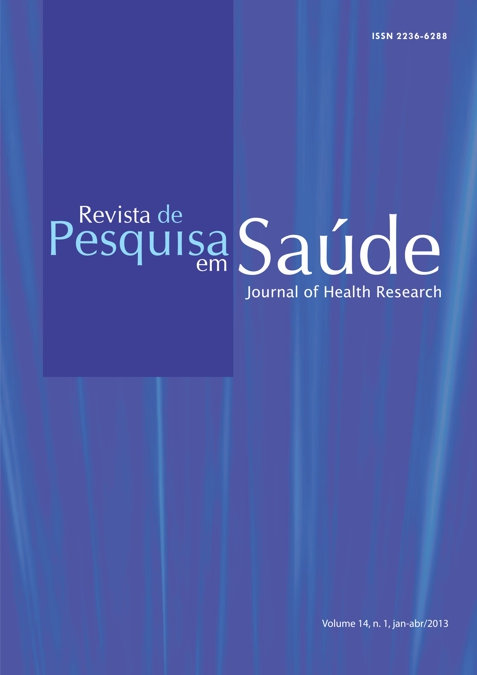VASCULARIZAÇÃO E GRAU DE ATIPIA EPITELIAL EM LESÕES PRÉ-NEOPLÁSICAS QUIMICAMENTE INDUZIDAS / VASCULARIZATION AND EPITHELIAL DYSPLASIA IN CHEMICALLY INDUCED PRENEOPLASTIC LESIONS
DOI :
https://doi.org/10.18764/Résumé
Introdução: A angiogênese é um importante fator nos processos neoplásicos, entretanto, seu papel no desenvolvimento de lesões pré-neoplásicas ainda é fonte de estudos. Objetivo: Avaliar a relação entre o número de espaços vasculares e o grau de atipia epitelial em lesões pré-neoplasicas induzidas na pele de camundongos hairless. Métodos: Foram utilizados 34 animais, sendo vinte do grupo de estudo (grupo A) e quatorze do grupo controle (grupo B). No grupo A foi pincelado DMBA a 0,5% no dorso dos animais durante 12 semanas (grupo A1; n=10) e 24 semanas (grupo A2; n=10). O grupo controle recebeu a aplicação de acetona por 12 (B1; n=7) e 24 semanas (B2; n=7), e ao final dos períodos, realizou-se a biópsia da pele para análise histopatológica. Nas lâminas histológicas foram avaliadas a atipia epitelial e o número dos espaços vasculares. Os dados foram submetidos à análise de variância e ao teste de Tukey (5%). Resultados: A análise revelou que 80% do grupo A1 e 100% do A2 apresentaram gradação intensa de atipia celular e aumento no número de vasos neoformados, quando comparados ao grupo B. Conclusão: No modelo estudado, a vascularização foi relacionada ao grau de atipia epitelial nas lesões pré-neoplásicas.Palavras-chave: Angiogênese patológica. Gradação neoplásica. 9,10-dimetil-1,2-benzantraceno.
Abstract
Introduction: The angiogenesis is an important factor in neoplastic process; however, its role in preneoplastic lesions is still in investigation. Objective: to evaluate if there is a relationship between the number of vascular spaces and the degree of epithelial atypia in preneoplastic lesions induced by DMBA in hairless mice skin. Methods: Thirty-four animals were divided into an experimental group (group A=20 mice) and control group (group B= 14 mice). The group A animals received 0.5% DMBA in the skin during 12 weeks (group A1; n=10) and 24 weeks (group A2; n=10). The control group received the acetone application during 12 (B1; n=7) and 24 weeks (B2; n=7). At the end of these periods, the skin lesion was biopsied for histopathology analysis. The histological slides were evaluated according to the epithelial atypia and the number of vascular spaces. The data were submitted to analysis of variance (ANOVA) and Tukey test (p<0.05). Results: We found that 80% of A1 group and 100% of A2 had severe epithelial atypia and high number of vascular spaces when compared to the group B. Conclusion: In the methodology used in this study, the vascularization seems to be related to the degree of epithelial atypia in preneoplastic lesions.
Keywords: pathologic angiogenesis. neoplastic grading. 9,10-dimethyl-1,2-benzanthracene.
Téléchargements
Les données relatives au téléchargement ne sont pas encore disponibles.
Téléchargements
Comment citer
Masa, A. P. P., Severo, M. L. B., Carmo, E. D. do, Pereira, A. C., & Rosa, L. E. B. (2013). VASCULARIZAÇÃO E GRAU DE ATIPIA EPITELIAL EM LESÕES PRÉ-NEOPLÁSICAS QUIMICAMENTE INDUZIDAS / VASCULARIZATION AND EPITHELIAL DYSPLASIA IN CHEMICALLY INDUCED PRENEOPLASTIC LESIONS. Revista De Pesquisa Em Saúde, 14(1). https://doi.org/10.18764/
Numéro
Rubrique
Artigos Originais / Original Articles
Licence
Direitos autorais Revista de Pesquisa em Saúde
Este obra está licenciado com uma Licença Creative Commons Atribuição-NãoComercial-SemDerivações 4.0 Internacional.







